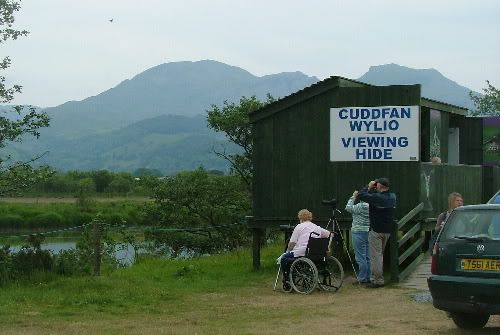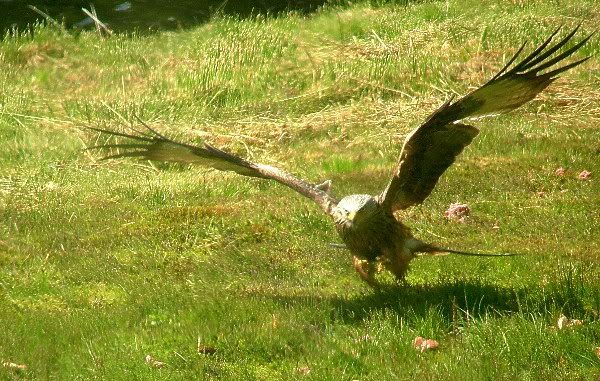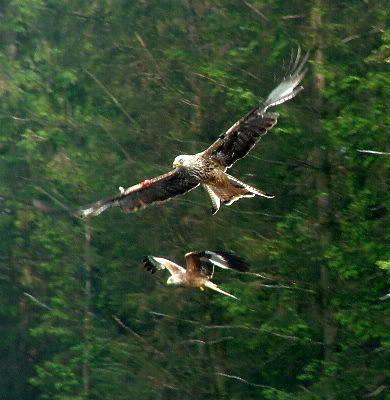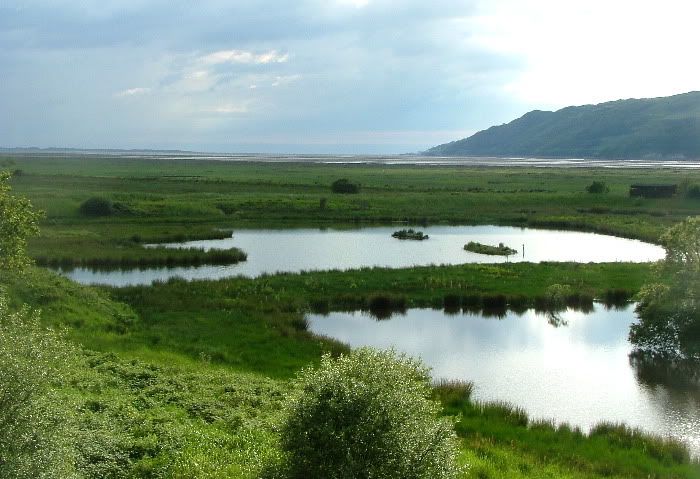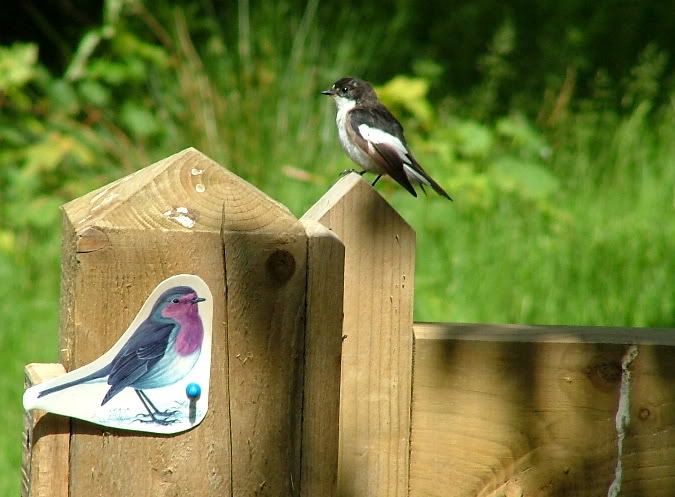A quick post to wrap up the Wales trip. On the way across we bisected Cheshire, very close to a nature reserve were Black-winged Stilts were still nesting. Didn't expect us to pass that by without taking a look, did you?
This was only the 7th known occurrence of nesting in Britain for this species (found more usually around the Mediterranean coasts), unusually two or possibly three pairs breed in Nottinghamshire in 1945, with a handful of other records since then. Cue the RSPB and their Aren't Birds Brilliant team to watch over the birds and show them to the public. You couldn't miss them...
Ridiculous and beautiful looking birds really, my girlfriend labelled the male bird 'daddy long-legs' and you can easily see why - indeed proportional to body size they have the longest legs of any bird in the world. Not only strange by appearance, the parent bird had the habit of carrying the chick around under its wing, so you'd see the adult stood with two legs poking from its armpit and know where the chick was.
Sadly it was only one chick. The clutch hatched during a stormy night which the rest of the brood failed to survive, and now regrettably I have read that the one chick has been taken by a predator since our visit to the site. Just 1 week away from fully fledgling too.
So for this year, that particular spectacle is over. Let's see if the Stilts pop up anywhere next Spring. Keep an eye out for ridiculous birds, all right?
Maybe you'll find a long-stayer worthy of naming, like Sammy, a remarkable bird that took residence at the RSPB's Titchwell Reserve for 12 years from the mid-90's. Thought at the time to be the most photographed bird in the UK, beat that Kate Moss!
Wednesday 25 June 2008
Friday 20 June 2008
GOP

Wales again, another ABB, the Glaslyn Osprey Project in Snowdonia. If you're in the region it's the perfect diversion, and though the nest is over a mile away from the viewing area the RSPB's scopes give great sights of these majestic birds that can't fail to thrill. The project has its own blog, check it out here.
Yes, that is Snowdon in the background there, the pointy peak centre left.
Labels:
abb,
Aren't Birds Brilliant,
glaslyn,
glaslyn osprey project,
grebes. nesting,
ospreys,
RSPB,
snowdonia,
wales
Thursday 19 June 2008
Aren't Kites Brilliant!
Continuing the birding story of my holiday in Wales, the next feathery target were the Red Kites at the Forestry Commission's feeding station at Nant-yr-Arian, in central Wales about 9 miles east of Aberystwyth, where an ABB project runs most days through the year. Around 100 birds arrive everyday at three in the afternoon to snatch a quick easy meal, swooping down with great dramatic poise to pick up their prize, usually chicken we're told, tossed to them by the rangers. This apparently helps improve breeding success, especially during dry spells when parent birds find difficulty in digging up their main prey item - worms.
Here's the video...
(another video here)
The hide is 20 yards from the feeding area, so you can view the Kites at very close quarters indeed.
Now truth be told, the profusion of Red Kites there lasts most of the afternoon, you really can't miss them in your anywhere around the site, and after an hour or two you begin to take them for granted. This has to be a marvellous thing, to be tired of Red Kites! After the entire Welsh (and therefore British population) at one point came down to just a handful of pairs, indeed research into their genetics tells that all Welsh kites are descended from just one female, these numbers indicate the most amazing recovery for the species.
There are up to 400 pairs now in Wales, and without hyperbole their survival has to be one of the great stories in nature conservation anywhere in the world. What a remarkable achievement! So even if the feeding stations feel a little like Red Kite theme parks, all is forgiven.
Of course you don't have to go to Wales for Red Kites anymore, there are birds from reintroduction schemes around much of England now, and some fairing a little less well in Scotland. The Welsh will tell you these are 'non-native' Red Kites since they came from European populations and perhaps they have a point. Truth be told, there is an argument that the RSPB jumped to quickly to reintroduce Red Kites to the UK from other countries. It's a cautionary tale.
Other birds around the site included Buzzards, Ravens, Siskin, and practically in the car park you have Tree Pipit.
Back to the Kites, and more pictures...
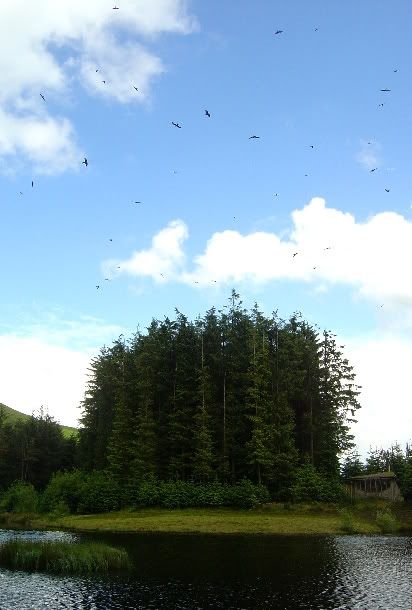
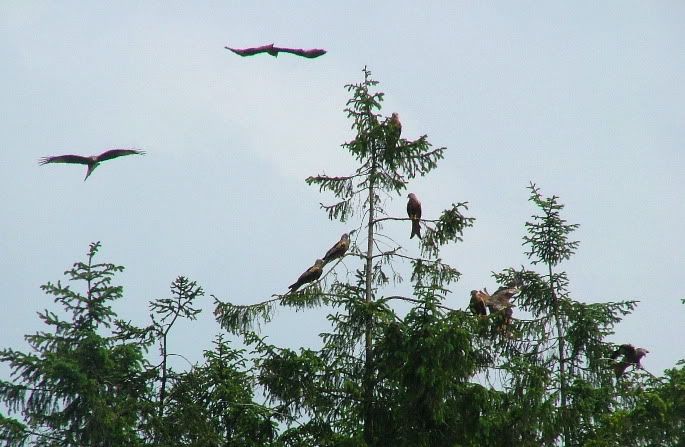
Here's the video...
(another video here)
The hide is 20 yards from the feeding area, so you can view the Kites at very close quarters indeed.
Now truth be told, the profusion of Red Kites there lasts most of the afternoon, you really can't miss them in your anywhere around the site, and after an hour or two you begin to take them for granted. This has to be a marvellous thing, to be tired of Red Kites! After the entire Welsh (and therefore British population) at one point came down to just a handful of pairs, indeed research into their genetics tells that all Welsh kites are descended from just one female, these numbers indicate the most amazing recovery for the species.
There are up to 400 pairs now in Wales, and without hyperbole their survival has to be one of the great stories in nature conservation anywhere in the world. What a remarkable achievement! So even if the feeding stations feel a little like Red Kite theme parks, all is forgiven.
Of course you don't have to go to Wales for Red Kites anymore, there are birds from reintroduction schemes around much of England now, and some fairing a little less well in Scotland. The Welsh will tell you these are 'non-native' Red Kites since they came from European populations and perhaps they have a point. Truth be told, there is an argument that the RSPB jumped to quickly to reintroduce Red Kites to the UK from other countries. It's a cautionary tale.
Other birds around the site included Buzzards, Ravens, Siskin, and practically in the car park you have Tree Pipit.
Back to the Kites, and more pictures...


Labels:
abb,
Aren't Birds Brilliant,
birdwatching,
ceredigion,
red kite,
red kites,
RSPB,
video,
wales
Monday 16 June 2008
Ynys-hir
Another swift post to sum up the best of the birding enjoyed on my camping holiday to NW Wales.
Top spot had to be the RSPB reserve at Ynys-hir, never heard of it? Me either before I went, but I am quite comfortably confident it's the finest RSPB site I've ever been to. Where to begin describing the plethora of habitats? The oak woodlands? The mudflat estuary? The fresh water pools? Or how about the reed beds and open pasture? I could go on.
As you may imagine, this extraordinarily rich variety offers a true wish-list of summer birds in early June... maybe 10 pairs of Pied Flycatcher by our straw count, almost as many Redstart, and best of all a single Wood Warbler - a lifer for the girlfriend and I. May have been too late in the day for the bird's amazing stuttering trill song (listen here), however a plaintive 'tuh' contact call quite unlike anything I've heard from a Willow Warbler of Chiffchaff helped to confirm with our ears what we seeing with our eyes through the thick green foliage.
In at least three of the hides we found nesting pairs of Swallow, probably my girlfriend's favourite part of the whole holiday came in watching them toing and froing, watch out for the video at the bottom of this post.
Other top sights for the two days spent there (we simply had to go back after the first one!) were family groups of Raven and Stonechat, a single Whinchat, display flights from Common Sandpiper, overflights from Little Egret, Sedge/Reed/Grasshopper Warbler among the reeds, Oystercatchers and Lapwings, hovering Common Buzzards, Siskin and Great Spotted Woodpecker visiting the feeders by the visitor centre/shop, and a sunbathing Treecreeper - stubby wings outstretch against tree trunk, to name the highlights.
For me most memorable of all was a Goldfinch nest riding the strong winds in the outermost branches of an oak tree at eye level from one of the hides - rising and falling five to six feet after every gust. We couldn't have planned to see a Goldfinch feeding its day old chicks, which trust me is an extraordinarily privileged view into the precarious early days of those birds.
Some pictures to illustrate all this beauty...
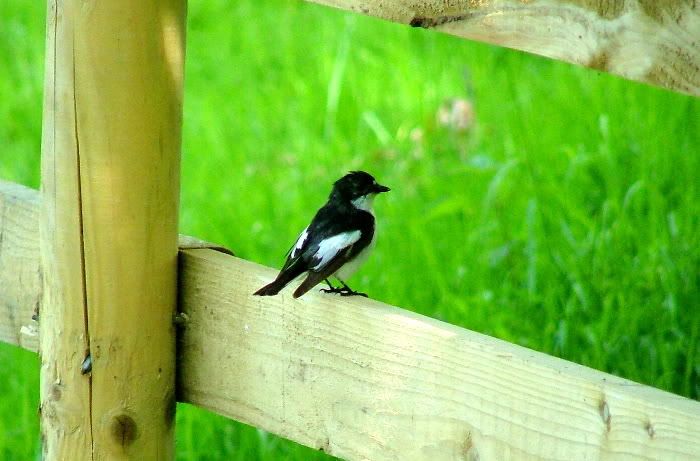
Those Swallows.
Top spot had to be the RSPB reserve at Ynys-hir, never heard of it? Me either before I went, but I am quite comfortably confident it's the finest RSPB site I've ever been to. Where to begin describing the plethora of habitats? The oak woodlands? The mudflat estuary? The fresh water pools? Or how about the reed beds and open pasture? I could go on.
As you may imagine, this extraordinarily rich variety offers a true wish-list of summer birds in early June... maybe 10 pairs of Pied Flycatcher by our straw count, almost as many Redstart, and best of all a single Wood Warbler - a lifer for the girlfriend and I. May have been too late in the day for the bird's amazing stuttering trill song (listen here), however a plaintive 'tuh' contact call quite unlike anything I've heard from a Willow Warbler of Chiffchaff helped to confirm with our ears what we seeing with our eyes through the thick green foliage.
In at least three of the hides we found nesting pairs of Swallow, probably my girlfriend's favourite part of the whole holiday came in watching them toing and froing, watch out for the video at the bottom of this post.
Other top sights for the two days spent there (we simply had to go back after the first one!) were family groups of Raven and Stonechat, a single Whinchat, display flights from Common Sandpiper, overflights from Little Egret, Sedge/Reed/Grasshopper Warbler among the reeds, Oystercatchers and Lapwings, hovering Common Buzzards, Siskin and Great Spotted Woodpecker visiting the feeders by the visitor centre/shop, and a sunbathing Treecreeper - stubby wings outstretch against tree trunk, to name the highlights.
For me most memorable of all was a Goldfinch nest riding the strong winds in the outermost branches of an oak tree at eye level from one of the hides - rising and falling five to six feet after every gust. We couldn't have planned to see a Goldfinch feeding its day old chicks, which trust me is an extraordinarily privileged view into the precarious early days of those birds.
Some pictures to illustrate all this beauty...

Those Swallows.
More Welsh birding to come.
Wednesday 11 June 2008
Flying Entry
Big update soon about my holiday away in NW Wales, but for now just a few local notes. Seems a while ago now (three weeks) that I scored with Black Tern back on the local patch at King's Mill Reservoir. This year they've been just about everywhere and seen by just about everyone, so I'm glad I got mine!
Lovely, elegant birds in summer plumage, and very graceful they are too hawking for insects at the surface waters. Their dark tones, relative small size, I don't mind admitting it took a minute or two of sifting through the large hirundine flock to pick out our bird.
It scored well with the girlfriend test, she was well impressed.
Last night we had a unsuccessful forray to Budby Common in search of Nightjar. We heard them all right, at least two, probably three chirring after 10pm, that was the extent of it though. What did show were Woodcock, we more than a dozen sightings of them roding above the treelines with that strange croaking and hiccupping display call. Can't say I'm disappointed after that!
We shall return though, possibly for Nottinghamshire Birdwatchers' Nightjar walk on June 20th.
So stories and pictures from Wales next time...
Lovely, elegant birds in summer plumage, and very graceful they are too hawking for insects at the surface waters. Their dark tones, relative small size, I don't mind admitting it took a minute or two of sifting through the large hirundine flock to pick out our bird.
It scored well with the girlfriend test, she was well impressed.
Last night we had a unsuccessful forray to Budby Common in search of Nightjar. We heard them all right, at least two, probably three chirring after 10pm, that was the extent of it though. What did show were Woodcock, we more than a dozen sightings of them roding above the treelines with that strange croaking and hiccupping display call. Can't say I'm disappointed after that!
We shall return though, possibly for Nottinghamshire Birdwatchers' Nightjar walk on June 20th.
So stories and pictures from Wales next time...
Subscribe to:
Posts (Atom)

